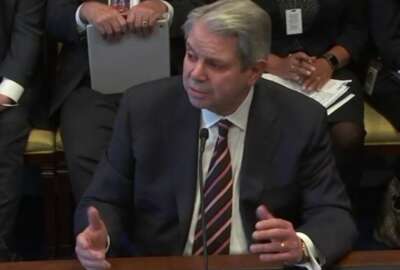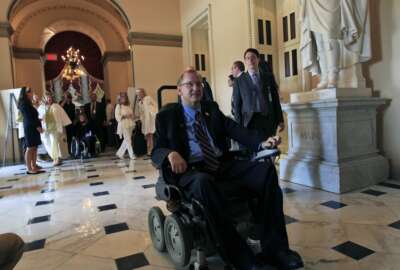

The legislative branch doesn't lack for watchdog offices, but as agencies continue to adopt emerging technology at an accelerating pace, lawmakers and...
Best listening experience is on Chrome, Firefox or Safari. Subscribe to Federal Drive’s daily audio interviews on Apple Podcasts or PodcastOne.
The legislative branch doesn’t lack for watchdog offices, but as agencies continue to adopt emerging technology at an accelerating pace, lawmakers and good-government groups have renewed their calls to bring back the Office of Technology Assessment.
Before it was defunded by Congress in 1995, OTA helped lawmakers understand technology-focused policy issues through deep-dive reports.
A bloc of House lawmakers last summer aimed to restore funding to OTA with $2.5 million in the fiscal 2019 spending bill for the legislative branch, but the House voted against that version of the bill last June.
However, the launch of a new House select committee on modernizing Congress, chaired by Rep. Derek Kilmer (D-Wash.), has renewed hopes of eventually resurrecting OTA.
Maurice Turner, a former Senate Homeland Security and Governmental Affairs staffer, now a senior technologist at the Center for Democracy and Technology, said congressional committees, also facing reduced staffing levels, lack for objective research on technology policy.
Without OTA, advocacy groups, think tanks and associations have looked to fill that void, but Turner said those briefings always come with some level of bias.
“You’re always going to be a little bit skeptical of what is coming into your office when it’s coming into your inbox, when it’s coming from outsiders,” Turner said. “I think that if there is a larger pool of trusted resources available to congressional staff, it would be beneficial to the development of policy.”
Sasha Moss, previously a staffer for former Rep. Blake Farenthold (R-Texas), now a federal government affairs manager at the R Street Institute, agreed that OTA can serve as an impartial policy adviser in ways that think tanks cannot.
“We have our own interest, and we will give you our personal academic perspectives,” Moss said. “But you should have a non-biased perspective at hand, as well — and also that can be called on any moment.”
Whether or not Congress restores OTA, the Government Accountability Office already has plans to expand its roster of science and technology experts.
By the end of this year, the GAO will grow its information technology and cybersecurity team from 140 employees to 175, and in the near future, Comptroller General Gene Dodaro told members of the House Appropriations Committee on Wednesday that he’d like to see the agency’s new Science, Technology, Assessment and Analytics Team grow from 70 employees to 140 employees.
However, GAO has also called on Congress for a substantial $58 million budget increase for fiscal 2020 — nearly a 10 percent increase from enacted levels.
Just as well, since attracting top talent to a newly reestablished OTA won’t come cheap, as the government continues to compete with the private sector for new graduates with in-demand skills and degrees.
“I think there needs to be some sort of a pipeline, even if it’s only on a temporary basis, to get more people who have this expertise into Congress for a short period of time,” Turner said.
In the executive branch, the staff behind the U.S. Digital Service and 18F have helped agencies improve their websites. And for years, the IRS has urged Congress to reauthorize the critical pay authorization, which would allow the IRS to compete with Silicon Valley for top cybersecurity talent.
“Maybe we can get to the point where it becomes more attractive, so people do actually want to spend a career, or a portion of a career in Congress, providing that level of expertise, but that’s going to come at a fairly high cost, because you’re going to have to pay market rate for this expertise,” Turner added.


Daniel Schuman, a former Congressional Research Service attorney, now the policy director for Demand Progress, said the legislative branch, in general, has suffered from staffing cuts since OTA was defunded.
By his estimation, the House has nearly 1,000 fewer staffers now than it did 25 years ago, and the Government Accountability Office has lost about 2,000 employees within the same period of time.
Dodaro told members of a House Appropriations subcommittee Wednesday that Congress has over the years reduced its own staff, and the staff of its supporting agencies, to its detriment.
“Over the years, I’ve always said that I think that that’s a mistake to keep reducing,” Dodaro said. “Even at its height, the legislative branch is so out-personed, if you will, compared to the executive branch that it’s hard to conduct the oversight over those areas. And issues are happening more rapidly now, in the development of science and technology issues.”
Those staffing shortages on the Hill, Moss said, put congressional staffers in the difficult position of cramming to become subject matter experts for hearings.
“Point blank, staff don’t have enough time to learn complex subject matter in sometimes less than 48 hours,” Moss said.
That time crunch also doesn’t do members of Congress any favors when getting briefed for committee hearings.
“I think the worst kept secret in D.C. is that there’s a 10 a.m. hearing, the congressman is looking at the questions at 9:59 [a.m.] and reading their binder at exactly 10 a.m., if they get to the dais and if they get to the hearing room on time,” Moss added.
While the legislative branch can’t staff up the size of the executive branch — which includes more than 2 million federal employees — Schuman said it can at least maintain comparable institutions.
“When you see the way that Congress has been set up, it is often done so in juxtaposition to what the executive branch has, because you shouldn’t rely just on the president for information,” he said.
Much like how the Congressional Budget Office provides oversight to the White House’s Office of Management and Budget, Schuman said OTA should serve as a counterpoint to the White House’s Office of Science and Technology Policy (OSTP).
OSTP played a leading role in the executive order President Donald Trump signed Feb. 11 focused on making artificial intelligence research and development a top priority for agencies.
However, OSTP director Kelvin Droegemeier, speaking less than a week after the executive order was signed, expressed concern that the U.S. doesn’t have a clear headcount of how many researchers and institutions are actually working on AI across the government, the private sector and non-profit sectors, and academia.
Copyright © 2025 Federal News Network. All rights reserved. This website is not intended for users located within the European Economic Area.
Jory Heckman is a reporter at Federal News Network covering U.S. Postal Service, IRS, big data and technology issues.
Follow @jheckmanWFED
